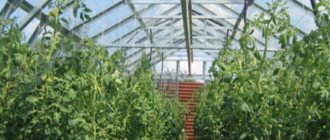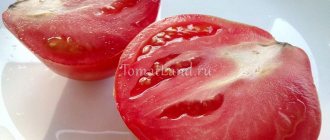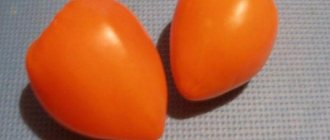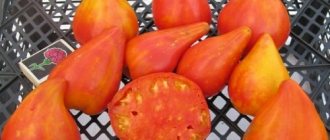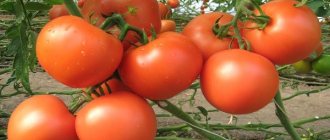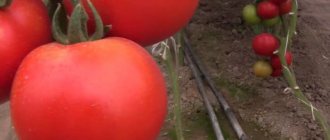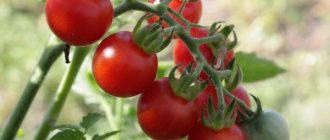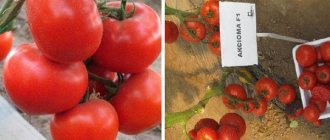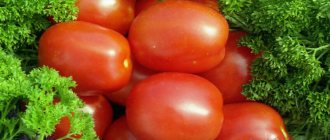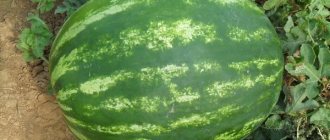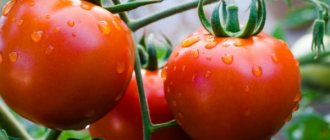Those who like to experiment with growing unusual varieties of vegetable crops will not ignore the Auria tomato variety. It is famous for its very high yield and taste of its fruits.
| Height | Landing location | Ripening time | Fruit color | Fruit size | Origin | Fruit shape |
| Tall | Greenhouse, Open ground | Mid-season | Reds | Average | Hybrid | Pepper-shaped |
Description and characteristics of the variety
The hybrid is indeterminate, non-standard. It reaches a height of 1.5-2 meters. The bush is a liana-like plant, medium-leaved, with a flexible trunk. In terms of ripening, it is classified as mid-season. Large stems are densely covered with carved leaves of light green color.
Due to the irregular shape of the fruit, the Auria tomato is also called Fun, Lady's Caprice, Manhood, Eros or Adam. Tomatoes have an oblong shape with a forked end. Unripe fruits are green-yellow, becoming bright red when ripe. The cut has a uniform red color, no white veins. Auria tomatoes are 12-14 cm long and weigh 150-180 g.
The flesh is fleshy and dense. They have an attractive aroma and rich taste. There are very few seeds in the chambers.
Country of origin
Tomato Auria is a very young hybrid. It was bred in 1997 by Novosibirsk breeders, but to this day it is gaining popularity among gardeners.
Which regions are best to grow in?
In the middle zone and Siberia, the plant requires greenhouse conditions for cultivation. The climate of the southern regions allows for growing tomatoes in open ground.
Planting and care
The Auria tomato variety was bred in southern latitudes and is therefore thermophilic. In the temperate zone, 2 methods of growing the variety are practiced:
- In open ground - southern regions of Russia and Ukraine;
- In greenhouses - northern Ukraine, Belarus, central Russia.
Sowing seeds and seedlings
For sowing, fruit seeds are selected from the most productive bushes, since the quality of the parent plants is genetically transmitted. Sowing seeds for seedlings is carried out 55-60 days before planting in the ground (February). Seedlings are placed in greenhouses and greenhouses in May. Planting in open ground beds takes place in June.
To improve germination, seeds are soaked before sowing. Sowing is carried out to a depth of 1 cm in specially prepared containers. For seedlings to appear, optimal conditions are created (+22+25 C). Shoots emerge in 5-8 days. The seedlings are moved to a bright windowsill and the temperature is maintained within +17 +20 C.
For the correct formation of Auria bushes, it is necessary to carry out gartering of the stem and branches, and pinching. Planting density depends on the number of axial stems in the bush. Single-stem plants are planted at the rate of 3 specimens per 1 sq.m. However, experienced gardeners advise leaving 2 shoots. In this case, the density will drop to 2 pieces per 1 sq.m.
Rules of care
During the growth period, the plant requires moderate watering (2 times a week) with warm, settled water. The soil must be periodically loosened in the root zone to improve oxygen penetration. From time to time the plantings are weeded. Nitrogen-containing fertilizers should be applied as fertilizing during the period of active growth, and substances containing phosphorus and potassium during the fruiting period.
On a note!
Before planting, as well as during the ripening period of tomatoes, it is advisable to add wood ash to the soil.
Features of cultivation and storage
Many farmers use a commercial soil mixture to sow seeds, but it can also be prepared at home. The composition includes ordinary humus and soil (in a 1:1 ratio) with the addition of peat. During growth, you need to fertilize the soil with potassium 3 times.
Suitable soil for growing tomatoes is considered to be the same soil on which carrots, cauliflower, parsley, dill or cucumbers were previously grown. These plants provide the soil with suitable organic matter, which contributes to a good tomato harvest. Due to the fact that the fruits of Auria tomatoes do not overripe, they can be stored for a long time.
Under no circumstances should you grow tomatoes in soil where potatoes or eggplants grew. These vegetable crops suffer from similar diseases and are exposed to the same pests.
Advantages and disadvantages
The Auria variety has the following positive qualities:
- Good tolerance to temperature changes and lack of moisture.
- Resistance to many diseases.
- High yield.
- Great taste.
- Integrity of fruits over a long period of time.
The disadvantages of Auria include the following:
- Plant fragility.
- Seeds are not sold in all stores.
- Incompatible with some fertilizers.
THESE VARIETIES DID NOT FAIL
Tomatoes are my passion. I think it’s unlikely that any other culture can boast such a variety of colors, shapes and flavors of fruits. And even the same variety can, depending on the gardener’s skill and weather conditions, surprise with its capabilities. But this applies to already known ones, but what can we say then about unexpected new products? And there really is something to talk about here. So I’ll share some impressions.
EVERYTHING YOU NEED FOR THIS ARTICLE IS HERE >>>
So, a couple of years ago I added to my garden collection with varieties of tomatoes, which are popularly called “manhood”, “female happiness” (or Ladies’ whim)
From reliable, in my opinion, sources, their correct name is Auria (red, large) and Eros (yellow, also large, although somewhat smaller in size than the first). Their homeland is Israel, but they are perfectly adapted even to the conditions of central Russia. In all my thirty years of “tomato” experience, I saw such a miracle for the first time. And I admit right away: now I will never refuse them, especially since I have always given preference to tall varieties, because they are more interesting to care for and their fruits are larger. All this fully applies to Auria and Eros
(photo 1). They turned out to be very productive, and their fruits are not only tasty, but also perfect for pickling.
But most importantly, it seemed to me that these varieties are also resistant to late blight!
For example, last year, summer and autumn in our area were cold and rainy, so, despite all the preventive measures, Madame Late Blight still showed up - as always, without an invitation.
And, as always, she began to go wild - I had to remove all the tomatoes from the greenhouse, with the exception of these amazing newcomers. They bloom, set fruits that slowly become ripe - and no signs of disease!
And they bore fruit almost until the end of the season, although by that time there were already periodic frosts outside. All the neighbors who came to visit couldn’t believe their eyes: their tomatoes had long lived, but mine were so splendid. Everyone then asked for either seeds for divorce or at least one fruit.
By the way, it was no coincidence that I mentioned that these are tall tomatoes. Those who fully correspond to this definition are them. By mid-July, the height of the bushes reached the ceiling of the greenhouse (and it’s about two meters in mine), I had to urgently cut off their tops. As a result, it turned out that the bulk of the fruits also hung almost from the ceiling. Collecting them, of course, was somewhat difficult, but the picture inside the greenhouse was truly fantastic!
Moreover, as the bushes grew, I only cut off the leaves and did not touch the stepsons, so new stems grew rapidly from them. Yes, not according to the rules, but there was much more fruit. And what “hats” adorned the bushes!
Growing in open ground
For outdoor cultivation, it is very important to choose the right place in the garden where the auria tomato will grow. Its productivity largely depends on this
The landing site should be high and protected from the wind. It is better if legumes, salads or root vegetables grew in the garden in previous years.
The future planting site should be fertilized with organic fertilizer. One bucket of manure per square meter is enough. m. Seedlings are planted in the beds in early June. But if you build arches and cover the plants with film, you can do it at the very end of May. To do this, holes are dug at a distance of 30-70 cm from one another. Each depression is filled with a solution of potassium permanganate to disinfect the soil.
The “auria” tomato, together with a lump of earth on the roots, is lowered into the hole and sprinkled with soil up to the first leaves. The bushes are immediately tied to a pre-installed support; there is no need to water them now, but only after a couple of weeks.
Caring for outdoor tomatoes is simple. They are watered rarely, once a week is enough. They are weeded and planted in a timely manner. When the bush grows to the desired height, the top is pinched. This way, nutrients will be spent on the growth of fruits, not foliage.
Auria tomatoes are almost not susceptible to fungal diseases. But other vegetables also grow in the garden, and the disease can spread to tomatoes. Therefore, you should inspect them daily.
Yield indicators of tomato Auria
The yield of the Auria tomato variety is high, especially with the correct formation of the bushes. Each shoot grows up to 6-7 racemose inflorescences, from each of which you can collect up to 600-700 g of fruit. In total, at least 5 kg of ripe fruits are removed from each bush.
How to grow seedlings
The easiest way to grow Auria tomatoes is by seedling method. Planting material is purchased from trusted stores or garden centers. The main work on seed preparation is carried out in mid-February.
Seed preparation
Proper preparation of planting material is the key to obtaining a high-quality and abundant harvest of vegetables.
- Planting material is carefully sorted, getting rid of cracked, damaged or deformed specimens.
- The selected seeds are placed on the bottom of the jar and filled with a solution of water and salt.
- After 15-20 minutes, empty, non-viable seeds will float to the surface of the container, and whole specimens will settle to the bottom.
- After sorting, the seeds are washed and dried at room conditions.
- To avoid the development of diseases, planting material is treated with an antibacterial solution. This solution is made from manganese or purchased in specialized stores.
- Next, the seeds are wrapped in gauze and poured with warm water for 10-12 hours. As soon as the water cools down, it is replaced with warm water. For faster germination of seed material, a growth stimulator is added to the water.
After the preparatory work, the seeds are wrapped in a damp cloth and left until the first roots appear.
Advice! In order for plants to easily tolerate temperature changes, it is recommended to harden the seed material. To do this, place the container with the seeds on the bottom shelf of the refrigerator and leave it there for 10-12 hours.
Dates and sowing pattern
The timing of sowing seeds for seedlings depends on the climate zone and the further method of growing the vegetable crop. If the tomatoes are intended to be transferred to open ground, then sowing activities are carried out 2 months before the proposed work. For greenhouse cultivation of tomatoes of this variety, seeds are planted 1.5 months before transferring the seedlings to their permanent place of residence.
- For planting seeds, select spacious containers in the form of pots or boxes.
- The containers are thoroughly washed and scalded with boiling water.
- Fertile soil is poured into each pot. It is best to use ready-made soil purchased at the store. If the soil is taken from a personal plot, before planting the seeds, it is treated with a manganese solution and heated in the oven at a temperature of at least 160 degrees.
- Holes or grooves, 1 to 1.5 centimeters deep, are dug on the soil surface, into which the seeds are placed at a distance of 1 centimeter from each other.
- The top of the planting is sprinkled with earth and moistened with a spray bottle.
- After planting is completed, containers with seeds are covered with film and sent to a warm room.
- As soon as the sprouts appear, the covering material is removed, and the containers with the plantings are moved to a warm, bright room.
Expert opinion
Stanislav Pavlovich
Gardener with 17 years of experience and our expert
Ask a Question
Important! Before the sprouts appear, the film is removed daily for 30-40 minutes to provide the soil and planting material with oxygen.
Germination and picking
Caring for seedlings involves timely watering and, if necessary, fertilizing. Also, after 2-3 tomato leaves appear, densely planted plants dive. To do this, leave the strongest and most viable sprouts in the container. The remaining shoots are removed or planted in different pots.
15-20 days before transferring the plants to their permanent place of growth, the seedlings are hardened off by taking the pots with the plants outside every day.
How to grow tomatoes
After 2 months, the seedlings are ready to be transplanted into open ground - after the threat of night frosts has passed and the ground has warmed up to 15°C. They are transplanted into the greenhouse 2 weeks earlier.
Landing
Planting pattern: 50 cm – distance between seedlings, 40 cm left between rows. For 1 sq. m place 3-4 seedlings.
Planted in shallow holes, first filling them with water and adding a little wood ash to the bottom of each. After transplanting, the soil is watered again, loosened and the young bushes are left to adapt to the new conditions for 1 week.
Auria tomato care
After adaptation, regular watering is established 2 times a week. Water moderately with warm, settled water, strictly at the root. After each watering, the soil is loosened, removing weeds with roots, which promotes better penetration of oxygen to the young roots.
To retain moisture, the beds are mulched. Additionally, mulching serves as a necessary preventive measure in pest control.
On hot and dry days, the amount of watering is increased to 3-4 times a week, making sure to control the level of humidity in the beds, since the crop is susceptible to fungal diseases.
The first feeding is carried out 10 days after transplanting into the ground. Feed with superphosphate or mullein infusion in a ratio of 1:10.
The second feeding is carried out during flowering. Feed with a full complex of mineral fertilizers or organic matter. Not only mullein infusion, but also bird droppings at a dilution of 1:15 are suitable as organic matter during this period.
The third time the crop is fed during the ripening of the fruits, adding potassium salt to mineral fertilizers or organic matter for faster filling of vegetables.
Features of cultivation and possible difficulties
Tall bushes require staking, otherwise they will not support the weight of ripe vegetables. They are fixed to the support as soon as the stems reach a sufficient height. The support is provided by wooden stakes installed next to each bush, or metal rods. Not only the stem of the plant is fixed, but also the fruit-bearing branches.
For proper distribution of nutrients, plants need to be pinched.
The pinching procedure is carried out early in the morning so that the resulting wounds heal completely by the evening. This reduces the risk of infection. The plant is formed into 1 or 2 stems. This technique helps to achieve maximum yield.
Diseases and pests
The tomato variety Auria has average resistance to diseases of the nightshade family. Most often it infects neighboring crops
Therefore, it is important not to plant plants of its family nearby.
The tomato is susceptible to blossom end rot and dry spotting. With blossom end rot, dark brown spots appear on the fruits, making the vegetables unfit for consumption. It will not be possible to save the affected fruits, but spraying with Bordeaux mixture will stop the development of the fungus.
The drug "Antrakol" will help cope with dry spotting. This disease, like blossom end rot, is a fungal disease. Therefore, prevention is needed first. This includes weeding, loosening, and moderate watering.
Greenhouse structures must be ventilated, since a constant flow of fresh air destroys the pathogenic environment.
Among the pests that are dangerous to tomatoes are whiteflies, spider mites, Colorado potato beetles and aphids. To eliminate whiteflies, pheromone traps are installed. They capture only harmful butterflies, without harming non-pest insects.
The habitat of spider mites is greenhouses. To destroy the parasite's habitual conditions, it is enough to regularly ventilate closed structures.
A soap solution used to treat the stems saves from aphids. The Colorado potato beetle is collected by hand and burned in glass jars.
Features of caring for an adult tomato
Continuing to consider the description of the Auria tomato variety, it is worthwhile to dwell in more detail on the features of caring for an adult plant. The crop is characterized by high yield, which means the plant needs a lot of nutrients. Auria is very fond of feeding with organic matter and mineral fertilizers. Despite its resistance to drought, tomato responds well to timely, abundant watering. The soil around the roots should always be loose.
The Auria bush is a vine and needs to be pinched. The plant is formed into 2 stems, and all other stems are removed. As the stems grow, they are tied to a trellis. Branches with bunches of tomatoes are supported, otherwise they will break off under the weight of the fruit. A prerequisite for the Auria variety is the removal of excess leaves. Usually this is the lower tier. Plus, they tear off the leaves near each brush, leaving 2 or 3 pieces.
Returning to fertilizing, it is worth noting that for tomatoes of the Auria variety it is usually enough to apply fertilizer three times during the entire growth period:
- when planting seedlings;
- during flowering;
- with the appearance of the ovary.
This amount of fertilizing is considered normal if the site has fertile soil. Otherwise, the frequency of fertilization is selected individually.
In general, the Auria variety is considered heat-loving. In the northern regions, cultivation is allowed only in heated greenhouses, and the result is not always successful. If the air temperature drops to zero, the inflorescences will begin to fall off.
Important! You can collect seeds from Auria for propagation. You just need to choose powerful, well-developed bushes with a lot of fruits.
Tomatoes ripen no earlier than 115–125 days from the moment the sprouts peck. Auria from 1 m2 under normal growing conditions can produce up to 12 kg of fruit. The harvested crop is usually immediately sent for processing and conservation.
Features of the seedling period
Sowing seeds must be done 60 days before planting tomatoes in a permanent place. The peculiarity of the seedling period is that the tomato shoots are very thin, elongated and tender. Planting must be done carefully, trying not to damage the shoots. When planting, you must immediately install supports and tie the shoots to them: the tomato stem will remain fragile even in adulthood. Inappropriate garter methods leave marks on the stems, which injures the plant and is a gateway to infection.
Feeding tomatoes usually begins two weeks after planting and is carried out regularly at intervals of ten days.
Tomatoes of this variety have the property of being perfectly preserved on the bushes; they do not overripe for quite a long time. The collected fruits have good keeping quality.
Vegetable growers have divided opinions about the Auria variety, but in some gardens it takes pride of place.
Video
Pests and diseases
The description of tomatoes of this variety indicates stable resistance to diseases. But in reality, it often turns out that bushes on acidic soil begin to suffer from blossom end rot. You can get rid of this misfortune as follows:
- Water more often.
- Treat plants with a 1% solution of copper sulfate and lime 2–4 times during the summer.
- Reduce soil acidity by adding dolomite flour.
This tomato variety has pests such as aphids, spider mites, and whiteflies. The best way to fight them is with an Arrow. Plants resist many infections well, but dry spotting can affect them. The drugs Antrakol and Tattu help with it.
